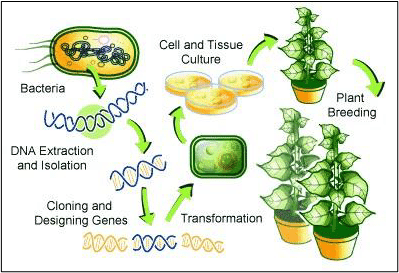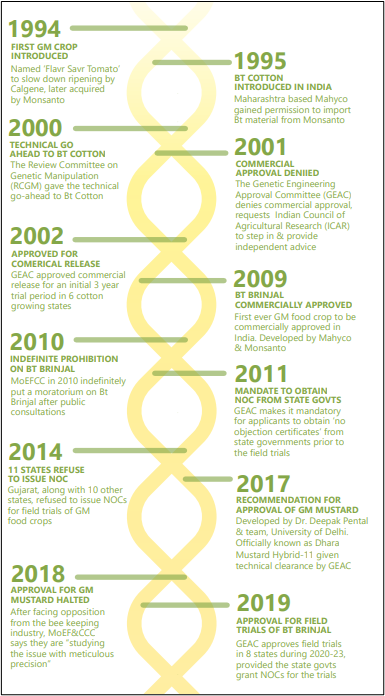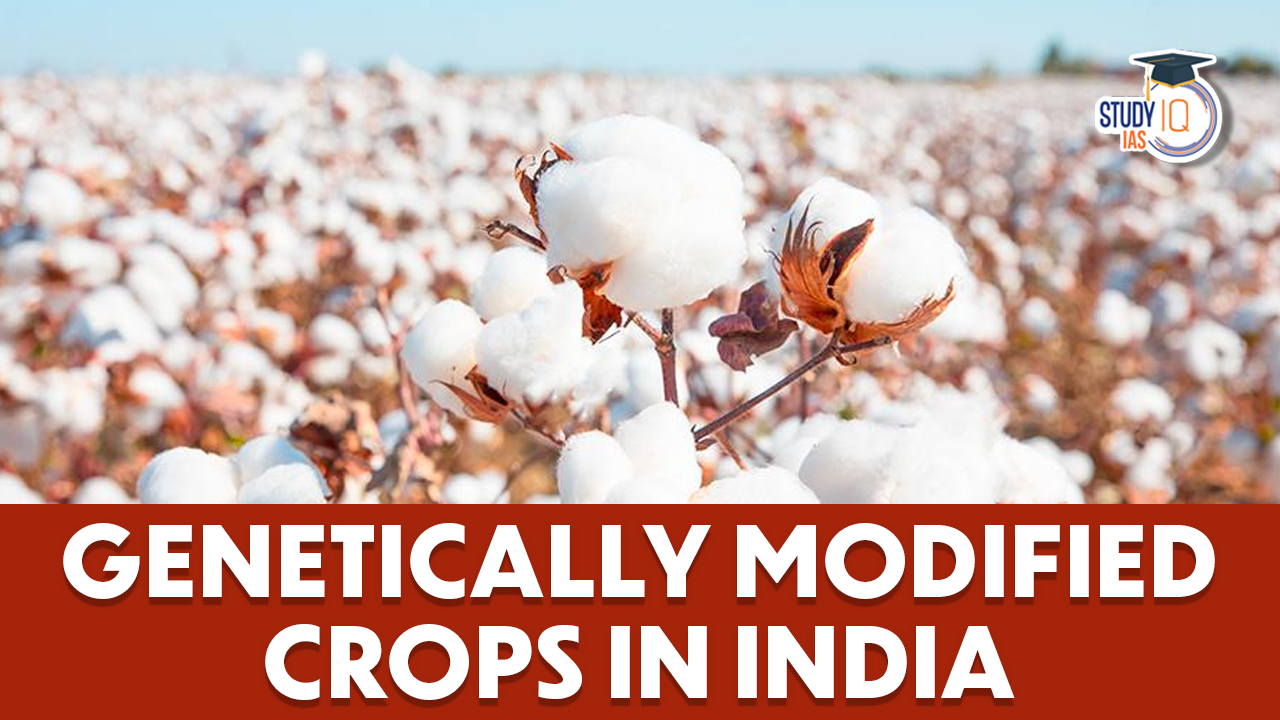Table of Contents
India’s growing population presents a significant challenge in meeting the increasing demand for food. Genetically modified (GM) crops offer a potential solution to this challenge. This article explores the history, advantages, challenges, and future prospects of GM crops in India, focusing on the latest developments and regulatory landscape.
Genetically Modified Crops (GM Crops)
Genetic modification (GM) is a technology that involves inserting DNA into the genome of a host organism. In plants, this process entails incorporating a specific DNA segment into the plant’s genome to introduce new or altered traits, such as disease resistance

Examples of GM Crops
- Bt Cotton: Engineered to produce a protein from the bacterium Bacillus Thuringiensis (Bt) that is toxic to certain insect pests.
- Reduces the need for chemical insecticides, protecting the cotton crop from damage.
- Golden Rice: Modified to produce higher levels of beta-carotene, a precursor of vitamin A.
- Aims to address vitamin A deficiency, a major public health concern in many developing countries.
- Drought-Resistant Crops: Engineered to tolerate drought conditions better by introducing genes that help the plant conserve water or withstand dehydration stress.
- Insect-Resistant Eggplant (Bt Brinjal): Produces a protein toxic to certain insect pests, similar to Bt cotton.
- Reduces the need for chemical insecticides, benefiting both farmers and the environment.
- Papaya Ringspot Virus-Resistant Papaya: Genetically modified to resist the papaya ringspot virus, which had previously devastated papaya production in Hawaii.
- Flavr Savr Tomato: One of the first genetically modified foods.
- Engineered to have a longer shelf life by suppressing the gene responsible for softening and decay.
- Resistant Cassava: Modified to resist viral diseases that can significantly reduce yields.
- A staple crop in many parts of the world.
- Frost-Tolerant Strawberries: Genetically modified to tolerate frost, allowing for extended growing seasons in colder climates.
- Non-Browning Apples: Engineered to resist browning when sliced or bruised.
- Helps reduce food waste and increase shelf life.
- Dhara Mustard Hybrid-11 (DMH-11): DMH-11 is a domestically developed transgenic mustard known as an Herbicide Tolerant (HT) variant.
- This hybrid results from crossbreeding the Indian mustard variety ‘Varuna’ with the East European variety ‘Early Heera-2’.
- Created by: Delhi University’s Centre for Genetic Manipulation of Crop Plants (CGMCP), National Dairy Development Board (NDDB) and the Department of Biotechnology.
- Incorporated: Two foreign genes, ‘barnase’ and ‘barstar’, sourced from the soil bacterium Bacillus amyloliquefaciens, which facilitate the creation of high-yielding commercial mustard hybrids.
- DMH-11 has demonstrated a yield increase of about 28% over the national check and 37% over the zonal checks, and its usage has received approval from the Genetic Engineering Appraisal Committee (GEAC).
- The “Bar gene” is crucial for maintaining the genetic integrity of the hybrid seed.
Advantages of GM Crops
- Pest Resistance: Bt genes are toxic to many pests, eliminating the need for external chemical applications.
- Example: Bt cotton produces a protein from the bacterium Bacillus thuringiensis (Bt) that kills certain insects.
- Herbicide Tolerance (HT): HT crops resist broad-spectrum herbicides, enabling targeted weed control without harming crops.
- Example: Glyphosate-resistant crops that reduce labour and emissions by eliminating tillage.
- Disease Resistance: Genetically modified to resist plant diseases, thereby reducing crop losses.
- Improved Nutritional Content: Developed to have higher nutritional value.
- Example: “Golden Rice” contains higher levels of beta-carotene, a precursor of vitamin A.
- Better than Conventional Breeding: Genetic modification is a superior method for developing pest-resistant crops like Bt crops.
- It introduces desired traits more quickly than conventional breeding.
- Allows for genetic modifications that are impossible through conventional methods, such as introducing genes from different organisms.
- Drought Resistance: Plants can be modified to tolerate drought conditions.
- Reduces the use of groundwater.
- Sustainable Agricultural Practices: Enables farmers to use more sustainable practices, such as no-till farming, which retains carbon in the soil rather than releasing it into the atmosphere.
Arguments in Favour of GM Crops
- Global Use: GM technologies have been used for about 15 years in countries like Brazil and China.
- Support from Experts: Norman Borlaug, the father of the Green Revolution, supported GM food to combat hunger.
- Former Prime Minister Manmohan Singh saw biotechnology as crucial for food security.
- President Pranab Mukherjee advocated for addressing concerns by following international safety procedures.
- Indian intelligence agencies and agriculture scientists from institutions like IARI and ICAR support field trials for GM crops to assess their benefits and safety.
- Scientific Consensus: Prominent scientists, including those under MS Swaminathan, support GM crops.
- They argue that GM crops like Bt brinjal can reduce the need for harmful insecticides, which indirectly affect human health.
Arguments Against Genetically Modified Crops
- Economic Concerns: Organisations like Greenpeace argue that GM crops do not yield better results and can push farmers into debt.
- Farmers may lose their rights over seeds, being forced to buy from multinational corporations.
- The rising number of farmer suicides linked to Bt cotton is cited as a negative example.
- Irreversibility: Once GM crops are released into the environment, their effects cannot be reversed.
- Pest and Weed Resistance: Over time, pests develop resistance to Bt toxins, which will increase the pesticide use.
- Weeds rapidly develop resistance to glyphosate and other herbicides, prompting the use of more toxic alternatives like dicamba.
- Environmental and Health Concerns: Increased herbicide use, especially glyphosate, has potential long-term health risks, such as cancer, though this is still under study.
- Dicamba is harmful to neighbouring farms and non-GM crops.
Regulatory and Economic Considerations
- Cost and Accessibility: Advanced tools like CRISPR lower GM crop development costs, but regulatory expenses remain high.
- Regulatory systems often focus on the method (GM vs. non-GM) rather than specific traits or outcomes.
- Integrated Pest Management (IPM): Suggested as a balanced approach to pest control, avoiding extremes like complete pesticide bans or excessive reliance.
GM Crops in India – Timeline

- 2002: Introduction of Bt cotton in India.
- 2006: Activists filed a Public Interest Litigation (PIL) against GM crops in the Supreme Court.
- 2010: Environmental Minister Jairam Ramesh blocked the release of Bt Brinjal due to lack of consensus among scientists and opposition from brinjal-growing states.
- No objection certificates from states were made mandatory for field trials.
- 2012: The Parliamentary Standing Committee on Agriculture, in its 37th report, called for an end to all GM field trials in the country.
- 2013: New crop trials have been effectively on hold since late 2012 after a Supreme Court-appointed expert panel recommended a 10-year suspension until regulatory and monitoring systems could be strengthened.
- Environment Minister Jayanthi Natarajan put on hold all trials following SC panel suggestions.
- 2014: Environment Minister Veerappa Moily cleared the way for trials, reversing the earlier stance of his predecessors.
- The Genetic Engineering Appraisal Committee (GEAC) approved field trials for 11 crops, including maize, rice, sorghum, wheat, groundnut, and cotton.
- The NDA government approved field trials for 21 new varieties of GM crops such as rice, wheat, maize, and cotton. The GEAC rejected just one out of the 28 proposals up for consideration and six proposals for lack of information.
- 2016: GEAC gave the green signal to GM Mustard for a field trial, but the Supreme Court stayed the order and sought public opinion on the matter.
Regulation In India
- Environment Protection Act, 1986 (EPA): This act provides the overarching framework for the regulation of GM crops in India.
- Rules for the Manufacture, Use, Import, Export, and Storage of Hazardous Microorganisms, Genetically Engineered Organisms or Cells, 1989: These rules, notified under the EPA, specifically address the regulation of GMOs.
- Genetic Engineering Appraisal Committee (GEAC): Under the Ministry of Environment, Forest, and Climate Change (MoEF&CC), the GEAC is responsible for the appraisal of proposals related to the release of GM organisms and products into the environment.
- Biological Diversity Act, 2002: This act aims to conserve biological diversity and ensure the sustainable use of its components.
- Plant Quarantine Order, 2003: This order regulates the import of plants and plant products, including GM crops, to prevent the introduction of pests.
- Food Safety and Standards Act, 2006: This act ensures the safety of food products, including those derived from GM crops.
- Drugs and Cosmetics Rule (8th Amendment), 1988: This rule includes provisions related to the use of GMOs in pharmaceuticals.
Conventions Related to GM Crops
- Convention on Biological Diversity (CBD): This convention focuses on the conservation and sustainable use of biological diversity. It includes provisions related to the safe handling and use of GMOs.
- Cartagena Protocol on Biosafety: Adopted under the CBD, this protocol specifically addresses the transboundary movement of GMOs. It sets out procedures for the safe transfer, handling, and use of GMOs, particularly those that may have adverse effects on biodiversity.
- International Plant Protection Convention (IPPC): This convention aims to prevent the spread of pests affecting plants and plant products. It also plays a role in the conservation of plant diversity and the protection of natural resources, which includes considerations related to GMOs.
- Aarhus Convention: This convention, in collaboration with the Cartagena Protocol, addresses public access to information, public participation, and access to justice in matters related to GMOs.
Conclusion
- Agriculture’s conflict with nature is evident as feeding 8 billion people with the same land used for 6 billion requires 30% increased production efficiency.
- Environmental consequences attributed to GM crops are often not unique but part of the broader impact of modern agricultural practices.


 Vitamin D Deficiency: Causes, Symptoms a...
Vitamin D Deficiency: Causes, Symptoms a...
 GAURAV: Long Range Glide Bomb (LRGB)
GAURAV: Long Range Glide Bomb (LRGB)
 Gestational Diabetes Mellitus (GDM), Cau...
Gestational Diabetes Mellitus (GDM), Cau...





















